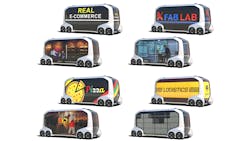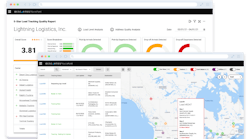Leasing was an innovation in vehicle ownership when it came about, and today the concept of selling vehicles one ride at a time — what's called mobility as a service, or MaaS — could create new multi-use possibilities for commercial vehicles and even help businesses save on freight costs in the process.
Different mobility concepts are taking shape at the same time, Navigant Research pointed out in a recent report, "The Future of Last-Mile Logistics." MaaS has been gaining ground as ride-sharing services like Uber and Lyft continue to grow in more cities, and a number of automakers are partnering with those and other MaaS companies and/or are working to develop autonomous ride-sharing fleets.
Indirectly, that could help solve another logistical difficulty: last-mile delivery. Ride-sharing MaaS companies help reduce the number of vehicles on the road and thereby decrease urban congestion by offering transportation at a lower cost per mile than owning a vehicle. Similarly, package and freight delivery companies have been working on innovative last-mile delivery and logistics alternatives to save costs and help navigate crippling city and metro area traffic.
"The biggest challenge for [last-mile logistics] is congestion and parking in large cities," Navigant noted in the report. "In the near future, a MaaS service for a city or local region is likely to deploy a fleet of automated vehicles ranging from single-person vehicles to minibuses designed to move large numbers of people to work during rush hour and deliver on-demand transport during off-peak hours."
That's where Navigant sees a convergence of possibilities. A MaaS fleet will likely have underutilized cargo space in those off-peak hours when the vehicles aren't moving as many people, so the idea is they could switch to delivering packages, food or larger items or collecting waste and recycling.
In terms of saving money, a range of companies that now need to operate a fleet of delivery vehicles — and assume all the costs involved therein — could potentially "hitch a ride" to move freight, packages, food orders and more if mixed-use ride-sharing-type services were available.
"If the fleet resource is shared effectively, operating single-purpose vehicles for delivery will no longer be necessary for many businesses," the report authors wrote. The study also examined technologies that are emerging in last-mile logistics such as drones, noting that they could aid in deliveries to remote locations.
Companies such as DHL already are using drones in that way or are using them in new delivery models such as Mercedes-Benz's Vans and Drones project. Amazon has been testing drone delivery for some time, as has Workhorse Group, which just launched a smaller electric delivery vehicle that can be spec'd with a drone in addition to its medium-duty delivery vans that fleets including UPS already are testing with Workhorse's Horsefly octocopter drone.
These developing technologies and logistics models might even help bring new vehicles to market that don't look much like today's commercial vehicles at all. Navigant suggested that "potential dramatic changes in vehicle manufacturing" could come about as mixed-use transport models emerge.
One example in that vein is Toyota's e-Palette Alliance announced last month at the Consumer Electronics Show. Toyota President Akio Toyoda showed off renderings of trolley-like autonomous vehicles that could serve as buses, mobile office space, storefronts, package delivery vans or even casinos. Daimler Group has also begun imagining what vehicles will be once people are no longer needed to pilot them with concepts like the smart vision EQ fortwo.
Before self-driving ones arrive, ride-sharing innovations such as Ford's Chariot service, which operates passenger vans on routes in cities based on crowd-sourced demand, may be able to bridge the mixed-services gap for commercial vehicles. However, the Navigant researchers placed a high value on autonomous vehicles fueling a potential mixed-use passenger/freight business model.
"Automated driving vehicles are critical for the success of these service models in the long-term," the report stated.





